Running an Aikido Dojo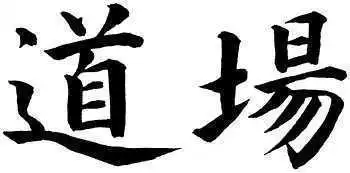 The ups and downs of leading an aikido dojo.The world proves to be quite a holistic place, like a hologram or a fractal picture. The shape of the whole is repeated in each of its fragments. Accordingly, what we experience in the subculture of aikido is usually quite true for society as a whole. That's one of the many good reasons for exploring aikido in every aspect of it. Of course, the major aspect of aikido is the training of it on tatami, the mat. That can only be done in a dojo, so there just has to be one for aikido to be explored at all. We were all lucky to find one, when we started training aikido, or we would have gone bowling instead. As time goes by, for some of us it becomes necessary to take over the responsibility for that dojo. For others there is no other way to continue training aikido than to form a dojo of their own. Don't hesitate to do it, when the necessity arrives! Our universe is one where survival and development are accomplished by regeneration. In the modest scale of aikido, this is done by new students joining the dojo, and by old students starting their own dojos. Learning aikido, from the very first awkward ukemi and onwards, is a mighty struggle. So is running a dojo. There is no shortcut, and if there were, it would be just as bland and boring as seeing Paris only on postcards. You have to do it for real, or it has not been done at all. I have started a couple of dojos, and I have witnessed the making and development of a few others. Here are some things that these experiences have taught me. Maybe they are of use to you, if you're in the same process.
You want training partnersYou know why you need a dojo: you simply want training partners. Maybe you took over a dojo when its former teacher left, or you star a brand new dojo because you moved to another town, or you needed a change because you wanted to pursue aikido in another direction than that of your old dojo — whatever the case, you need a dojo because you need training buddies for your continued aikido practice.Don't forget that. It is reason enough to go ahead and start a dojo, no matter how much trouble that will bring. It also gives you a compass that helps you in all the choices you need to make during the forming and the governing of the dojo. Choices that work well with your own training at the dojo are good, and other choices are bad. Of course, you must have a broader perspective than just the next class, but at the bottom line: you must want to train in the dojo, and long for the next class, or something is wrong.
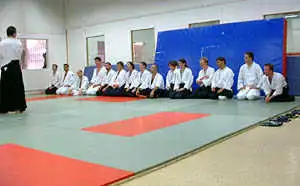 Aikido class in our dojo. So, don't hesitate to form the dojo and its training in accordance with your own preferences in aikido. If you prefer a certain style of aikido, allow the dojo to be devoted to it. If you like a small club with just a few members who are close friends and equals, then stick to that and don't bother about trying to make the dojo grow. The more the dojo agrees with you, the more you agree with it, and you will be an inspired leader of it. Consequently, if for some reason the dojo develops into something that doesn't suit you that well, don't hesitate to leave it. You can find another dojo to your liking elsewhere, or start a new one. It might not be the dojo changing, but you. Change is a basic force in the world. Don't expect things to be the same year after year, but expect things to change. That's the only way you can adapt. Still, until the day arrives when you feel like leaving the dojo, as long as you lead it: let it be governed by your personal preferences.
The first generationWhen a dojo is started from scratch, its first generation of members is of the greatest importance. They set the character of the dojo. If it's a joyous bunch of people, delighted in training and in the company of each other, then the dojo is sure to be a success. It will survive and prosper.That's no mystery, but remember its significance. Therefore, you should try really hard to get a number of people joining at the moment you start the dojo, and then you should dare to make the regular training true to the way you want to train aikido — even to the point of putting off people who are not willing or able to adapt to it. Don't change your aikido or the dojo system to attract a lot of people who would never want to train aikido the way you want to. That only leads to trouble and conflict, and might very well end in the dojo breaking up and closing.
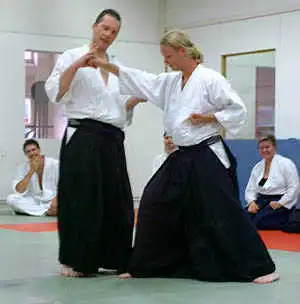 Aikido class in our dojo. When a dojo is started up, it easily becomes a tight club of homogenous minds. They form the solid core of the dojo — a force that surpasses even the power of the dojo's leader. When you start up a dojo, you are able to decide very much about what it's going to be, but when that tight club of its initial members is formed — then it has the strength to influence the leader much more than the leader can influence it. So, take care in how the first group of members is put together. Do what you can to keep the ones you really want to be part of it, and even try to ward off those that you feel are contrary to what you want the dojo to be. Don't worry about people leaving the dojo after a short while, if they don't like it there. It's much better with a small dojo where the members feel connected and in agreement, than a large one where everyone feels like a stranger. Surely, the dojo will not be exactly as you imagined it. As soon as a group starts to form itself, this group is what really leads the dojo on. Not you. This is a good thing, since it means that you are up for some surprises, too, and that's what makes the adventure adventurous. Do what you can with the initial forming of the dojo, then be prepared to step back a little bit to see what comes out of it. I can't stress enough the importance of the beginning of a dojo, actually its initial weeks and months. If you are prepared and treat that time well, the rest is so much easier than if you don't. For example, consider carefully how to advertise for your dojo. Don't stress the self-defense aspect if you're not personally into that. Don't use media or forums that mainly attract people of an attitude that is far from yours. In demonstrations, try not to show a way of doing aikido that differs much from what you like the trainings to be. Don't hesitate to let your members sweat both on the tatami and off it. Involve them in the work. Let them feel like pioneers, since that is essentially what they are. They don't need to be spoiled — quite the contrary. They want to feel involved and essential in the forming process of the dojo. Those who can't take the heat you don't want as members, anyway. Anybody who expects just to pay the fee and then be served is not fit to join a dojo. On the other hand, people who contribute to the dojo work with smiling faces, they are fit even if they have two left feet and never learn the difference between omote and ura.
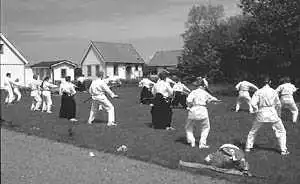 Outdoor sword training at our dojo. When you have the first generation of members in your dojo, make the training intense, make sure that you spend lots of time together also outside the tatami, take them with you to seminars, bring other aikido teachers to your dojo so that your members get to know them and feel connected to the aikido world as a whole. Don't worry about overdoing it. In the initial period of a dojo there is no such thing as overdoing it. Too much is not enough. Don't settle for anything less than far too much. Let your own perseverance be the only limit. Usually, the pioneering first generation of members in a dojo are the ones with the most stamina and resolve. Also, you are surely eager to get members that you can develop your own aikido by training with. Be impatient to develop them to that level — and beyond it.
The settling periodYou will probably keep your first generation of members for several years, and they will seem insatiable. Everyone trains hard, and everyone is devoted to the dojo and the training, as if nothing else in life really matters. You will have great fun.The dojo will settle and get its characteristics during these first few years. Its structure gets solid and its routines are established. These things need not be worked out before the start of it. It is actually better if they are formed along the way, so that they adapt well to the character of the dojo.
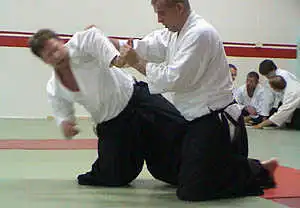 Kyu grading in our dojo. Therefore, avoid laying down a grading system in detail, way in advance. When your members progress in grades, you will be able to see what is needed for the next step. This way, your grading system will be much more relevant and workable, than if you had it all set down in advance. This is true also if you use an exterior grading system, for example that of Aikikai Hombu Dojo or of the aikido style you wish to belong to. You might not allow yourself to change the actual technical demands in the system, but you still have freedom in how you apply them — what you emphasize and what you regard as less important, what you look for in particular at each grade, what you might demand in addition to what's in the grading system rules, and so on. Any grading system needs to be more or less adapted to the dojo where it is to be used. Don't hesitate to do that, to the extent you feel at liberty. Otherwise your dojo risks becoming little more than a machine.
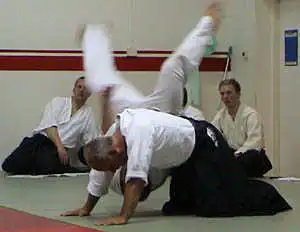 Kyu grading in our dojo. Never forget that grading is secondary, whereas training is primary. Grades should reflect how aikido is trained in your dojo. They should absolutely not force the training into a mold, so that the classes are little more than preparation for the next examination. I recommend you to make grading a fun event at regular intervals, but not give it an importance as if it were the goal of the training. It is not. Training is the goal of training. By training you get better at aikido — not to receive higher grades, but to get better at aikido. Still, treat grading with care, and make sure that the members feel respect and trust for its system. Actually, they will demand it.
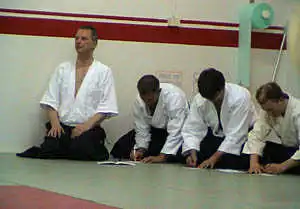 Kyu grading in our dojo. Regarding the schedule of the dojo, you should also be ready to adapt. The first generation of members will want to train as much as possible, but it is also important that they are really able to go to every class. Find a balance where this is somewhat possible, or there will soon be two levels of membership: those who always train, and those who can't do that. Well, maybe you want your dojo to consist only of the former group — then go right ahead. But I bet you will have a dojo consisting only of teens and people in their early twenties, without family, possibly without a job as well. Such a dojo is short-lived. As a general rule: let the dojo settle into a form that suits the majority — if not all — of your first generation members. If your dojo is a club, it needs a board and other organizational components. This is a matter of some delicacy. Which ones of the members should be in the board? It is natural that all the first generation members feel like equals, and this is a wonderful thing. It can easily be tainted or scarred by some of them given functions and titles putting them above the rest. A club must have statutes, a board, annual meetings, and so on. But during the pioneering first few years, it's best to treat these things with as little emphasis as ever possible, even if that means some neglect. Some decisions need to be made in the board or by the annual meeting, but they should be freely discussed among all the members beforehand, so that everyone feels involved in the decision process. There should be no surprises coming from the board. Its decisions — as well as those of the club's annual meeting — should be unanimous. If they are not, in the settling period of the club, there is a risk that something is going wrong. Actually, as soon as a formal vote is needed, it's reason for consideration.
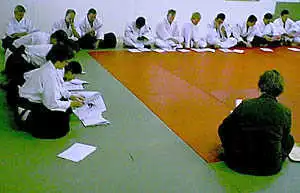 Annual meeting in our dojo. Usually, the one who starts a dojo becomes its Chairperson. Initially, this is hard to avoid, but it has a serious drawback: it implies a special importance to who the Chairperson is. Thereby, it makes the board and all the organizational matters elevated from the plane of the regular members of the club. If one of them is made Chairperson, the title loses some of that emphasis, but there are other risks. That person might get an attitude. The one who is elected Chairperson needs to be convinced of the insignificance of it. A good general rule is to search for a Chairperson among those members who do not want to be one, and to make sure not to elect one who is eager for it. This is true for the whole board, and any other appointment in the club. Look for those who need to be convinced to accept it, and avoid those who readily volunteer. Board meetings should be as few and as informal as possible. The annual meetings of the club are best held on the tatami, in immediate connection to a training class. And remember to let all the members participate in the discussions of matters that are important to the dojo, wherever the decision needs to be made formally. A good golden rule in the dojo, especially during its formative years, is: Let everybody be involved in everything.
Next generation membersOf course, the dojo needs other members than those of the first generation, but they will usually prove to be much more difficult to find and to keep than the initial members. It is the first generation members that are in the way, unknowingly.They participated in forming the club, by which they also sort of sealed it. The pioneering members of the dojo are closely bonded, forming the dojo into something similar to a family. It is not easy for new members, later on, to get equally accepted into this closed community. This is rarely outspoken. In most cases neither the old nor the new members are even aware of it. Still, it results in lots of new members leaving the dojo, while most of the first generation members remain, seemingly forever. Similar to a family, the only way to be fully accepted into a club where the first generation members dominate, is through the invitation and help of one of them. The core of a club is its inner circle, and as long as the first generation is mostly intact the inner circle is the whole club. If none of them makes an effort for new people to join, the club will continue to consist of only its first generation members.
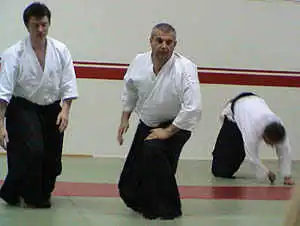 Ukemi training in our dojo. In Japan there is the system of sempai and kohai, which translates approximately to senior and junior. It exists in all parts of Japanese society, also in their dojos. When somebody joins a Japanese dojo, this person quickly finds support and guidance through one of the senior members. That person will be the beginner's sempai — for the rest of their lives. The beginner is kohai in relation to his or her sempai. It is a neat system, solving the problem of the inner circle enclosure. The sempai, who is a respected member of that circle, makes sure that the kohai is let in, and the other seniors of the dojo accept it out of respect for the sempai. With modification, this system can be used also in a dojo outside of Japan. It starts with the dojo leader. Usually, that's the head teacher — sensei, to use the Japanese term. If the teacher shows an interest in new members, the students will surely do the same. Still, the teacher cannot care about beginners to the extent that the senior students get neglected. In such a dojo it is better to be a beginner than to be advanced — a situation that quickly makes the dojo deteriorate. The teacher's main concern is the advanced students, but those in their turn should feel a responsibility to take care of newcomers. This is easily accomplished if senior students get to teach beginners classes, or at least assist the teacher at them in significant ways. So much in a dojo, if not all, is about teaching. Therefore, if senior students are involved in the teaching of newcomers, they will surely do all they can to make those people stay and continue their training.
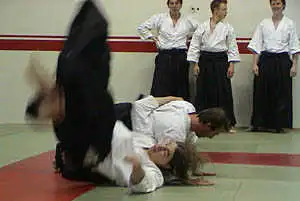 Ukemi training in our dojo. I think that's the bottom line of it. A dojo can attract new members if it pays attention to every link of the chain from the oldest to the newest members, but this has to be done in respect to the fact that seniority is an essential issue in a dojo. Like in Japan: you can never become your sempai's sempai, no matter what grade you get or how fast your aikido develops. Seniority has to be acknowledged, and it cannot be done away with. A dojo where seniority is ignored will lose its stability, so that neither seniors nor juniors feel comfortable in it. On the other hand, seniority does not need to be rigorously followed. It doesn't have to be only the oldest members in a club that are elected to its board, or appointed to teach the classes. But they have to be considered and respected, more so than what is necessary with the newcomers. The beginner should have a longing to become a senior in the future, and is therefore not at all opposed to a seniority system, as long as it has the dynamics of accepting new seniors in due order, as time goes on.
Bye to the first generationAfter some time it is bound to happen: the first generation of dojo members dissolves. If they were young at start, they get married, have kids, a demanding job, and so on. For whatever reason, the dojo will lose one after the other of its pioneering members.It starts with one or two of them. Although the loss is felt, the dojo and its inner circle remain intact. But then others go, at an increasing pace, and suddenly all but a few have disappeared into the world outside the dojo. Even if the first generation has been intact for, say, five years or more, they can all be gone within a year. I find this to be an accelerative process. The circle is broken, the bonds are loosened, so that most of the first generation members feel that their community is a thing of the past. They move on to other things in life. Also, when the first generation is no longer the majority of the dojo, they can feel a bit isolated or even rejected, like politicians not getting enough votes to stay in office. Members of later entry seem to take over. Well, it's a kind of retirement, as unavoidable as it is natural. The only one remaining might be the founding leader of the dojo. If the first generation members had become close friends, almost like siblings, it can get pretty lonely at the top for the dojo leader. It's like losing your teenage buddies after high school. It is sad.
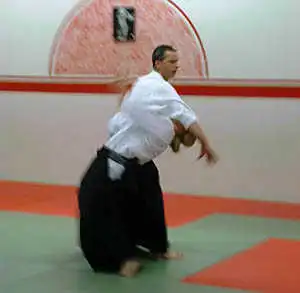 I instruct at a class in our dojo. What can you do? It happens to just about everyone who starts a dojo, so it would be nice to have a solution. There is none, as far as I know. But there is comfort to be found. The friends you made will remain your friends for the rest of your life, although you might not meet all of them that frequently. All of you will always cherish the memories you share. Even though many of them stop with aikido, they will continue to value what they learned through it. They happily admit to having gained richly from the experience, and so have you. Still, the foremost comfort lies in what is, and what is to come. There are junior students to assist in their development to seniors. There will be new beginners, whose talent is yet to discover and cultivate. To them you will be more of a parent than a sibling. The chain has no end. Think of it: what delights you the most — the aikido you were able in the past, or the aikido you hope to accomplish in the future? I thought so.
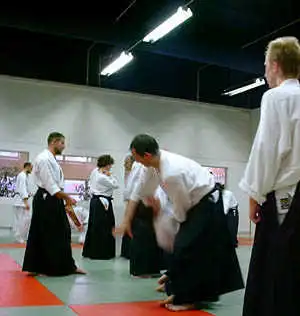 Aikido class in our dojo. When the first generation of members disappears, which tends to happen quite suddenly, your dojo is likely to have been diminished substantially. Not only are the members fewer, but more importantly: there is a big gap among the advanced students. Maybe you're left without any yudansha, black belt, and quite probably you will not have members with which to train on the level you were used to. People move on, that we know and can accept. But a dojo where you feel that you almost have to start over again — that's tough. So, sometimes it happens that also the founding dojo leader leaves, shortly after the first generation students. If that's what you really want to do, then do it. But not until you've seriously tried to persist. You have to give your dojo a second chance, for the sake of the members remaining, and those yet to come. If there is a big gap, so that almost all of the remaining members are of a much lower grade than the first generation, then you need to start by admitting to yourself that you didn't take proper care of the regeneration of the dojo. You didn't do enough to make newcomers welcome, or to assure that they were given a good enough training to develop as they should. You have to think of ways to improve in this respect. The next thing you need to do is to ensure that the most senior members of the ones remaining in the dojo are regarded as the core of the dojo, just as much as the first generation was before them. The trick is to make them feel that way. When the present seniors of the dojo feel like its seniors, they will help you to keep the dojo going. They will probably also make you feel motivated. A good way of doing it is to involve the senior students in making changes to the dojo. Because of the change of generations, the dojo needs other changes as well. Be daring, make it kind of a rebirth. If the seniors participate in this process, they become a first generation of sorts to this renewed dojo. You might find that they become just as enthusiastic, just as passionate and persistent, as the very first generation was. And you'll have fun again. Learn from the process. Then you'll do it better the third time around — and the fourth, and the fifth...
Learn by teachingIf you're the founding leader of a dojo, it's most likely that you are its head teacher as well. As you are well aware of when teaching your aikido students, the main inspiration in training aikido is the learning process. Students practice towards perfection. Without the perspective of improvement, training is mere body exercise — it might be necessary, but it's not much fun.Also the teacher needs to feel that he or she is improving, or it's just a job — with no or little pay, at that. So, who teaches the teacher? The students do. It's a fact, not just a neat democratic statement. To put it more generally: you learn by teaching. When you have to explain to students exactly how an aikido technique works and should be performed, you get to know it better than you ever did before, no matter how many times you trained it as a student in another teacher's classes. You have to show it, too, which makes you increasingly aware of its details and components, helping you to develop and refine it. You have to do the technique on students of differing ability and experience, and help them along as they try to do it on you. This makes you constantly examine and modify your technique. Teaching aikido is one of the very best ways of learning it. Every student working with a partner in regular training becomes aware of it. By helping each other along, they learn the techniques much faster and better than they would without that communication along the way — the mutual teaching. The head teacher learns a lot just by his or her own regular classes, but it's not enough. If you want your students to improve, to continuously surpass every limitation they come across in themselves, then that needs to happen to you, too. For that, you must also sometimes learn as a student.
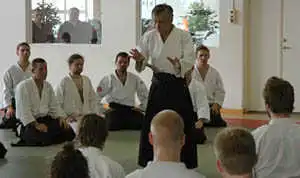 Tamura sensei seminar in our dojo. Go to seminars! Experiencing other teachers not only revitalizes your aikido and gives you ideas for how to modify your techniques. Also, you study a teacher at work, and thereby learn things about teaching. Invite other teachers to give classes in your dojo! It has the same benefits for you as when you travel to seminars elsewhere — and then some. You get a chance to be a student like the others, in your own dojo. It's relaxing and humbling for you, and it's a delight for your students, who thereby become more at ease with you. Don't worry about authority and respect — those things are automatic. The only way to counter them is by striving too hard to get them. In addition, when you invite another teacher to your dojo — or bring your students with you to a seminar elsewhere — your students are given a chance to learn more than what you can give them. It needs not be better or more advanced or anything like that, it just needs to be different from what you teach them. It gives them a chance to develop in their aikido to a point where you can indeed learn from them.
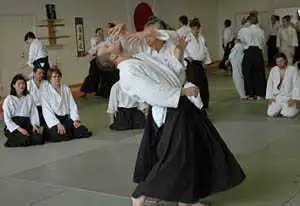 Tamura sensei seminar in our dojo. Any teacher's ideal is that the students should surpass him or her. But make them work for it, by your own continued development, at the same time as you do all you can to assist and inspire them in their progress. When you have a mutual learning process going on in your dojo, both you and your students have fun in class. It's necessary to have fun. Budo can sometimes be regarded with a grimness that drains it of joy, so that the only thing remaining is discipline and discomfort. Nobody learns anything in such an environment, and nobody really likes it. If you want to continue teaching, and if you want your students to remain and learn, then you need to have fun. You, the teacher, need to enjoy the classes — it's more important than that the students do, but actually they do if you do. Give yourself the freedom to teach in a way that you can enjoy, pursuing directions that attract you, forming the classes in ways that make you disappointed when the time is up — much earlier than you were prepared for. Don't worry about what seems to be egoistic about it. If you're not enjoying it, no one else is. Watch out for two things, though: pride and laziness. Pride makes you avoid teaching techniques of which you don't feel sure. Instead, you fill too much of your classes with the stuff that you excel at. Since practice makes perfect, you will surely improve on the techniques you already know well, but the rest of your aikido risks to deteriorate. Nor do you learn that much by it. Laziness is a slow-working poison. At the start it works much the same as pride: you avoid techniques that you are not comfortable with, for one reason or other, and spend excessive time on other techniques that you find easy to perform. Slowly, it can lead you to doing less and less as a whole, in your classes. A lazy teacher also avoids going to seminars or inviting other teachers to the dojo. Again, you don't learn much. So, learning is the key. When you're learning and improving, you enjoy yourself and all is fine.
Teacher of teachersIn his Book of Five Rings, the famous samurai Miyamoto Musashi wrote: "The teacher is the needle, and the student is the thread." As a teacher you lead the students on, in a spirit of their improvement being the reason for it all. The needle goes first, but the thread remains.It takes a lifetime — at least — to learn how to teach. Probably, there is no greater thing in human culture, so it is worth a lifetime to learn it. Along the way, you have students for varying amounts of time, and each new generation of dojo members gives you a chance to reform and renew the way you teach them. Use the opportunity. Question and revise the way you teach, from the details of how you present techniques at class or how you correct a beginner's footwork, to the long perspective of how to bring students to shodan level and onwards — to a point where they can be well prepared head teachers in dojos of their own. We should strive to have our students pass us by and become our superiors. But aikido is no competition. There is really no such thing as one aikidoka being better than another. We are different, that's all. A better goal for an aikido teacher, if there should at all be one, is to cultivate one's students until they can become teachers — to be a teacher of teachers.
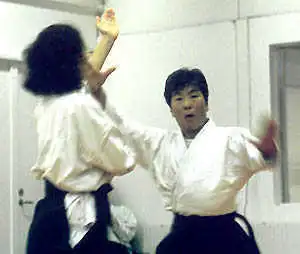 Minegishi sensei teaching in our dojo. That might take some time. Still, a teacher should not hesitate to let go of a student. There might be lots of things that the student can still learn from his or her teacher, but when the time comes the teacher must let go, anyway. If the student has gained the competence to be head teacher of his or her own dojo, it is probably high time. There's a Japanese saying: "Even on a stone, three years." It means that even if you want to learn something as simple as sitting on a stone, it takes three years. On the other hand — after three years you can sit on a stone. One Japanese application of the saying is that it takes three years for a student to realize what can be learned from any one teacher, so there is no point in changing teachers more often than that. Of course, if after three years you find that there is much more to learn from your teacher, you do wisely to stay with him or her. But it is also quite alright if you decide to find another. I am flattered and somewhat surprised when people remain as my students, even after three years. I change my attitude towards them, expecting them to take more of a personal responsibility for their continued aikido development. At that point they should have some initiatives of their own, such as visiting other dojos, going to seminars, maybe trying some other arts or in other ways adding ingredients to their training. Also, if they remain after those first three years, I regard them as permanently bitten by the aikido bug. They might stop training aikido, but it will stay in their bodies and minds, actually improving their ability in a subtle way. They have started a process within themselves that will not stop, just because they don't practice aikido anymore. And they may very well return to the tatami, one day.
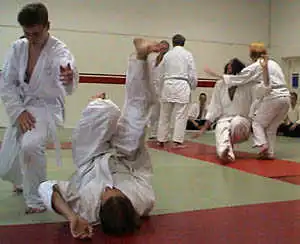 Kyu grading in our dojo. Maybe you can divide the aikido student's development into a fixed number of stages. If so, I think that they would be:
1 Beginner's stage.Traditional budo would say that this stage lasts until the student gets the black belt, but that's an exaggeration. I'd say it's the first year or two, depending on how intensely the student is training and how talented the student is.Here, the teaching needs to contain two elements: the drilling of aikido basics, and the occasional glimpse of what aikido can become in the long run. Without a proper amount of the former, the student may never be secure with the aikido techniques, and without the latter, any talented student would lose interest in aikido.
2 Intermediary stage.It starts at the time when the student has a comfortable ukemi technique, and can do many of the basic techniques in aikido without much hesitation. From this point the students usually develop very quickly, and need to train often and with vigor.I think that this is also the moment when they should start to wear the hakama, but on this point dojos differ greatly. Some don't allow it before shodan, others have different rules for men and women — which I find ridiculous. The most common rule for dojos outside Japan is to allow hakama when the student reaches the grade 3 kyu. If later, I fear that the good influence the hakama can have on posture and circularity of movement is lost. Students who have to wait too long for the hakama are already so fixed in their habits that it cannot help to correct them. On this stage the students need to train enough to develop quickly towards the next stage. They start to feel like advanced students, so they should be given the support to quickly become advanced. There is hardly any limit to how much they can be stimulated, or what feats they can accomplish. This is a very intense period in anyone's aikido development, and it is full of intense memories that we keep forever on. They still need to work on their basics, certainly, but they also need to discover how much they have already learned — even to show off, occasionally. They will sneak in such moments, whether the teacher allows it or not. Anyway, the teacher must work hard to keep these students challenged, or they will get bored — or quit at a later time, when challenges to their ability and perseverance are inevitable.
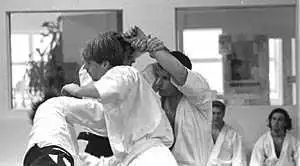 Taninzugake training in our dojo.
3 Advanced stage.It commences at the level usually associated with shodan, or right before that. The grade itself is not a trustworthy indicator, but the student has reached an ability that is unquestionable. The student also has a level of authority in his or her aikido. The advanced student is familiar with most of the aikido techniques, and comfortable also in teaching them to others.Maybe that's the best indication of the advanced student: the ability to teach others the aikido techniques. In comparison, the intermediary student might be able to teach others some aikido techniques, but rarely has the patience to do so, and misses important aspects when doing it. The intermediary student is much more interested in learning and doing, than in teaching. It is at the advanced stage that the student's interest in teaching commences and grows. Therefore, it is good if students on this level are given the opportunity to teach, parallel to their own continued training. For a continued development, the advanced students need to reexamine their techniques, although they can do them competently and comfortably. They learn this by teaching, but also by their teacher's intensified work with them. The teacher of advanced students must be able to heighten the demands accordingly, so that the students don't settle for the abilities they already have, but move on and on. The refinement of aikido is done by revision. Advanced students should question what they have learned. They should dare to let go of solutions they have trusted this far, so that they are open to continued improvement even when it means a change from what they know well into something that makes them feel like beginners anew. Of course, it takes an advanced teacher to make advanced students continue to learn, to challenge and inspire them. One should try to be realistic about to what level one can really teach one's students. If measured in dan grades — and that should be done with caution — you should ask yourself up to what dan grade you feel capable of leading your students. Your own grade can be an indication, but it is far from infallible. Whatever grade you have, and whatever grade your student reaches, there will come a day when you must admit to yourself that you don't have that much more to teach him or her. It's time for the student to move on — either by finding another teacher, or by starting his or her own dojo. It is best for the student to do both, if possible.
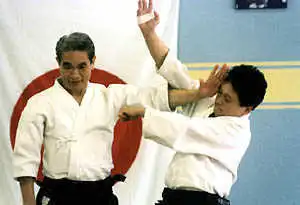 Nishio sensei seminar in our dojo.
4 Teacher stage.This arrives when the student is quite competent to have a dojo of his or her own, become its head instructor and take responsibility for the development of its students from the beginning to the advanced level. The competence signified by the grade 4 dan is probably where this stage commences, but again — grade alone is no guaranteed measurement.From this point on, the student is himself or herself responsible for his or her future development. Certainly, the student can have a teacher through whose instructions and guidance this development is helped greatly, but still the responsibility for it stays with the student. The teacher assists, but no longer leads. If a student on this level is neither willing nor able to find a new teacher or start a new dojo, the atmosphere in the dojo can get rather dense, as if crowded. It is. Too many teachers in a dojo risks splitting it into separate groups, giving birth to all kinds of conflicts. You can still make it work, if the teachers are given well-defined and separate responsibilities, but it's not easy. They all need to teach, and to do it in the way that they themselves prefer. That's hard to fit into just one dojo. If the head teacher of the dojo is very advanced indeed, even those who have reached the teacher stage may want to remain and continue studying for that teacher, as if nothing has happened. But something has happened, so the head teacher should treat them differently, more like honored guests than as students. And they should themselves work hard to make use of their teaching ability elsewhere, whether or not they also keep training in their original dojo. That's the real payment you owe to your teacher: to teach others.
Stefan Stenudd, November 2006
AIKIDO PRACTICEIntroductionAikido Techniques — all the basic movesAttacks in Aikido
Tantodori — knife defenseAikiken — aikido sword techniquesJo 31 Kata in four directionsAikibatto sword and staff exercisesAiki — joining energiesKi exercisesAikido Video ClipsAikido PhotosMy aikido dojo in Malmö, SwedenMy aikido seminarsAIKIDO THEORYMy Aikido BioAikido GlossaryTanden, the CenterAikido InksAikido as Self-DefenseRunning a DojoAikido is TrueOsensei and EinsteinAikiWeb ColumnsAikido Books ReviewedDie deutsche Version meines Aikido-Buches onlineAikido på svenskaAbout CookiesMy Other WebsitesCREATION MYTHSMyths in general and myths of creation in particular.
TAOISMThe wisdom of Taoism and the Tao Te Ching, its ancient source.
LIFE ENERGYAn encyclopedia of life energy concepts around the world.
QI ENERGY EXERCISESQi (also spelled chi or ki) explained, with exercises to increase it.
I CHINGThe ancient Chinese system of divination and free online reading.
TAROTTarot card meanings in divination and a free online spread.
ASTROLOGYThe complete horoscope chart and how to read it.
MY AMAZON PAGE
MY YOUTUBE AIKIDO
MY YOUTUBE ART
MY FACEBOOK
MY INSTAGRAM
MY TWITTER
STENUDD PÅ SVENSKA
|
 Aikido Principles
Aikido Principles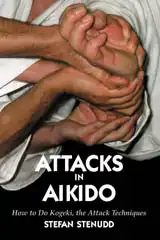 Attacks in Aikido
Attacks in Aikido Aikibatto
Aikibatto
